ROADTEST SLEEPER CABS
Page 42
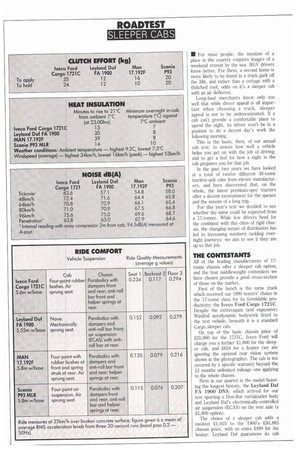
Page 43
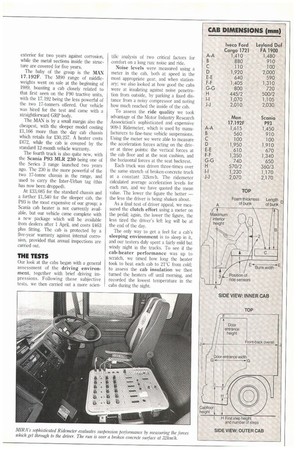
Page 44
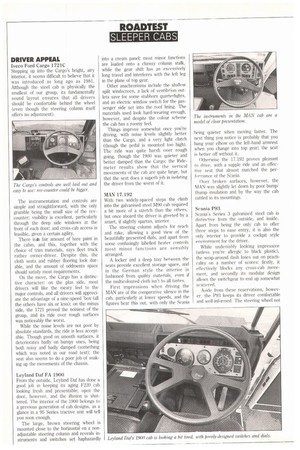
Page 45
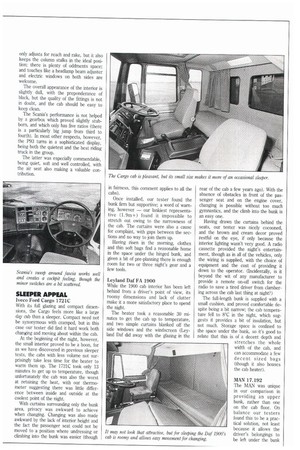
Page 46
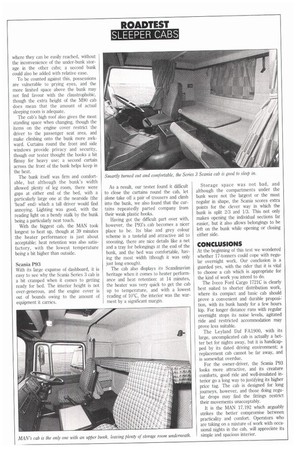
If you've noticed an error in this article please click here to report it so we can fix it.
II For most people, the mention of a place in the country conjures images of a weekend retreat by the sea. HGV drivers know better. For them, a second home is more likely to be found in a truck park off the M6, and rather than a cottage with a thatched roof, odds on it's a sleeper cab with an air deflector.
Long-haul merchants know only too well that while driver appeal is all important when choosing a truck, sleeper appeal is not to be underestimated. If a cab can't provide a comfortable place to spend the night, its driver won't be in a position to do a decent day's work the following morning.
This is the basis, then, of our annual cab test: to assess how well a vehicle helps you get on with the job of driving; and to get a feel for how a night in the cab prepares you for that job.
In the past two years we have looked at a total of twelve different 38-tonne tractive-unit cabs from eleven manufacturers, and have discovered that, on the whole, the latest premium-spec tractors offer a decent environment for the queues and the snooze of a long trip.
For this year's test we decided to see whether the same could be expected from a 17-tonner. While few drivers head for the continent with this class of rigid chassis, the changing nature of distribution has led to increasing numbers tackling overnight journeys: we aim to see if they are up to that job.
THE CONTESTANTS
All of the leading manufacturers of 17tonne chassis offer a sleeper cab option, and the four middleweight contenders we have chosen provide a good cross-section of those on the market.
First of the bunch is the same truck which received our 1990 testers' choice in the 17-tonne class for its formidable productivity: the Iveco Ford Cargo 1721C. Despite the extravagant (and expensive) Windfoil aerodynamic bodywork fitted to the test vehicle, beneath it is a standard Cargo sleeper cab.
On top of the basic chassis price of 231,860 for the 1721C, Iveco Ford will charge you a further 21,600 for the sleeper cab, and 2654 for a heater (we are ignoring the optional rear vision system shown in the photographs). The cab is not covered by a specific warranty beyond the 12 months unlimited mileage one applying to the whole chassis.
Next in our quartet is the model boasting the longest history, the Leyland Daf FA 1900 DNS, which arrived for our test sporting a Don-Bur curtainsider body and Leyland Dafs electronically-controlled air suspension (ECAS) on the rear axle (a 21,800 option).
The choice of a sleeper cab adds a modest 21,025 to the 1900's 20,885 chassis price, with an extra 2490 for the heater. Leyland Daf guarantees its cab exterior for two years against corrosion, while the metal sections inside the structure are covered for five years.
The baby of the group is the MAN 17,192F. The M90 range of middleweights went on sale at the beginning of 1989, boasting a cab closely related to that first seen on the F90 tractive units, with the 17.192 being the less powerful of the two 17-tonners offered. Our vehicle was hired for the test and came with a straightforward GRP body.
The MAN is by a small margin also the cheapest, with the sleeper model costing 21,166 more than the day cab chassis which retails for 230,257. A heater costs 2472, while the cab is covered by the standard 12-month vehicle warranty,
The fourth truck is also quite new, with the Scania P93 MLR 230 being one of the Series 3 range launched two years ago. The 230 is the more powerful of the two 17-tonne chassis in the range, and used to carry the Inter-Urban tag (this has now been dropped).
At 233,085 for the standard chassis and a further 21,540 for the sleeper cab, the P93 is the most expensive of our group; a Scalia cab heater is not currently available, but our vehicle came complete with a new package which will be available from dealers after 1 April, and costs 2463 plus fitting. The cab is protected by a five-year warranty against internal corrosion, provided that annual inspections are carried out.
THE TESTS
Our look at the cabs began with a general assessment of the driving environment, together with brief driving impressions. Following these subjective tests, we then carried out a more scien
tific analysis of two critical factors for comfort on a long run: noise and ride.
Noise levels were measured using a meter in the cab, both at speed in the most appropriate gear, and when stationary; we also looked at how good the cabs were at insulating against noise penetration from outside, by parking a fixed distance from a noisy compressor and noting how much reached the inside of the cab.
To assess the ride quality we took advantage of the Motor Industry Research Association's sophisticated and expensive 909-1 Ridemeter, which is used by manufacturers to tine-tune vehicle suspensions. Using the meter we were able to measure the acceleration forces acting on the driver at three points: the vertical forces at the cab floor and at the seat cushion, and the horizontal forces at the seat backrest.
Each truck was driven three-times over the same stretch of broken-concrete track at a constant 32km/h. The ridemeter calculated average acceleration levels for each run, and we have quoted the mean value. The lower the figure the better — the less the driver is being shaken about.
As a final test of driver appeal, we measured the dutch effort using a meter on the pedal; again, the lower the figure, the less tired the driver's left leg will be at the end of the day.
The only way to get a feel for a cab's sleeping environment is to sleep in it, and our testers duly spent a fairly mild but windy night in the trucks. To see if the cab-heater performance was up to scratch, we timed how long the heater took to heat each cab to 21°C from cold; to assess the cab insulation we then turned the heaters off until morning, and recorded the lowest temperature in the cabs during the night.
Iveco Ford Cargo 1 72 1C Stepping up into the Cargo's bright, airy interior, it seems difficult to believe that it was introduced as long ago as 1981. Although the steel cab is physically the smallest of our group, its fundamentally sound layout ensures that all drivers should be comfortable behind the wheel (even though the steering column itself offers no adjustment).
The instrumentation and controls are simple and straightforward, with the only grumble being the small size of the revcounter; visibility is excellent, particularly through the deep side windows at the front of each door; and cross-cab access is feasible, given a certain agility.
There isoi fair amount of bare paint in the cabin, and this, together with the choice of trim materials, says fleet truck rather owner-driver. Despite this, the cloth seats and rubber flooring look durable, and the amount of oddments space should satisfy most requirements.
On the move, the Cargo has a distinctive character: on the plus side, most drivers will like the meaty feel to the major controls, and all drivers will appreciate the advantage of a nine-speed 'box (all the others have six or less); on the minus side, the 1721 proved the noisiest of the group, and its ride over rough surfaces was noticeably the worst.
While the noise levels are not poor by absolute standards, the ride is less acceptable. Though good on smooth surfaces, it deteriorates badly on bumpy ones, being both noisy and badly damped (something which was noted in our road test); the seat also seems to do a poor job of soaking up the movements of the chassis.
Leyland Daf FA 1900 From the outside, Leyland Daf has done a good job in keeping its aging F220 cab looking fresh and presentable; open the door, however, and the illusion is shattered. The interior of the 1900 belongs to a previous generation of cab designs, as a glance in a 95 Series tractive unit will tell you soon enough.
The large, brown steering wheel is mounted close to the horizontal on a nonadjustable steering column and reveals instruments and switches set haphazardly into a cream panel; most minor functions are loaded onto a clumsy column stalk, while the gear shift has an excessively long travel and interferes with the left leg in the plane of top gear.
Other anachronisms include the shallow split windscreen, a lack of ventilation outlets save for some stubborn quarterlights, and an electric window switch for the passenger side set into the roof lining. The materials used look hard-wearing enough, however, and despite the colour scheme the cab has a roomy feel, Things improve somewhat once you're driving, with noise levels slightly better than the Cargo, and a very light clutch (though the pedal is mounted too high). The ride was quite harsh over rough going, though the 19(K) was quieter and better damped than the Cargo; the Ridemeter results show that the vertical movements of the cab are quite large, but that the seat does a superb job in isolating the driver from the worst of it.
MAN 17.192 With two widely-spaced steps the climb into the galvanised steel M90 cab required a bit more of a stretch than the others, but once aboard the driver is greeted by a smart, if slightly spartan, interior.
The steering column adjusts for reach and rake, allowing a good view of the beautifully presented dials, and apart from some confusingly labelled heater controls most minor functions are sensibly arranged.
A locker and a deep tray between the seats provide excellent storage spare, and in the German style the interior is fashioned from quality materials, even if the multicoloured cloth isn't to all tastes.
First impressions when driving the MAN are of the comparative silence in the cab, particularly at lower speeds, and the figures bear this out, with only the Scania being quieter when moving faster. The next thing you notice is probably that you bang your elbow on the left-hand armrest when you change into top gear; the seat is better off without it.
Otherwise the 17.192 proves pleasant to drive, with a supple ride and an effective seat that almost matched the performance of the Scania.
Over broken surfaces, however, the MAN was slightly let down by poor bump/ thump insulation and by the way the cab rattled in its mountings.
Scania P93 Scania's Series 3 galvanised steel cab is distinctive from the outside, and inside. Apart from being the only cab to offer three steps to ease entry, it is also the only interior to provide a cockpit style environment for the driver.
While undeniably looking impressive (unless you're allergic to black plastic), the wrap-around dash loses out on practicality on a number of scores: firstly, it effectively blocks any cross-cab movement, and secondly its modular design allows the switchgear to end up somewhat scattered.
Aside from these reservations, however, the P93 keeps its driver comfortable and well-informed. The steering wheel not only adjusts for reach and rake, but it also keeps the column stalks in the ideal position; there is plenty of oddments space; and touches like a headlamp beam adjuster and electric windows on both sides are welcome.
The overall appearance of the interior is slightly dull, with the preponderance of black, but the quality of the fittings is not in doubt, and the cab should be easy to keep clean.
The Scania's performance is not helped by a gearbox which proved slightly stubborn, and which only has five ratios (there is a particularly big jump from third to fourth). In most other respects, however, the P93 turns in a sophisticated display, being both the quietest and the best riding truck in the group.
The latter was especially commendable, being quiet, soft and well controlled, with the air seat also making a valuable contribution.
SLEEPER APPEAL
Iveco Ford Cargo 1721C
With its full glazing and compact dimensions, the Cargo feels more like a large day c-ab than a sleeper. Compact need not be synonymous with cramped, but in this case our tester did find it hard work both changing and moving about within the cab.
At the beginning of the night, however, the small interior proved to be a boon, for as we have discovered in previous sleeper tests, the cabs with less volume not surprisingly take less time for the heater to warm them up. The 1721C took only 13 minutes to get up to temperature, though unfortunately the cab was also the worst at retaining the heat, with our thermometer suggesting there was little difference between inside and outside at the coolest point of the night.
With curtains surrounding only the bunk area, privacy was awkward to achieve when changing. Changing was also made awkward by the lack of interior height and the fact the passenger seat could not be moved to a position where undressing or climbing into the bunk was easier (though in fairness, this comment applies to all the cabs).
Once installed, our tester found the bunk firm but supportive; a word of warning, however — our lankiest representative (1.9m+) found it impossible to stretch out owing to the narrowness of the cab. The curtains were also a cause for complaint, with gaps between the sections and no way to join them up.
Having risen in the morning, clothes and thin soft bags find a reasonable home in the space under the hinged bunk, and given a bit of pre-planning there is enough room for two or three night's gear and a few tools.
Leyland Oaf FA 1900 While the 1900 cab interior has been left behind from a driver's point of view, its roomy dimensions and lack of clutter make it a more satisfactory place to spend the night.
The heater took a reasonable 30 minutes to get the cab up to temperature, and two simple curtains blanked off the side windows and the windscreen (Leyland Ilaf did away with the glazing in the rear of the cab a few years ago). With the absence of obstacles in front of the passenger seat and on the engine cover, changing is possible without too much gymnastics, and the climb into the bunk is an easy one.
Having drawn the curtains behind the seats, our tester was nicely cocooned, and the brown and cream decor proved restful on the eye, if only because the interior lighting wasn't very good. A radio cassette provided the night's entertainment, though as in all of the vehicles, only the wiring is supplied, with the choice of equipment and the cost of providing it down to the operator. (Incidentally, is it beyond the wit of any manufacturer to provide a remote on-off switch for the radio to save a tired driver from clambering across the cab last thing at night?) The full-length bunk is supplied with a small cushion, and proved comfortable despite being a bit narrow; the cab temperature fell to 8°C in the night, which suggests it provides a bit of insulation, but not much. Storage space is confined to the space under the bunk, so it's good to relate that this is of a decent depth and stretches the whole width of the cab, and can accommodate a few decent sized bags (though it also houses the cab heater).
MAN 17.192 The MAN was unique in our comparison in providing an upper bunk, rather than one on the cab floor. On balance our testers found this to be a practical solution, not least because it allows the driver's belongings to be left under the bunk
where they can be easily reached, without the inconvenience of the under-bunk storage in the other cabs; a second bunk could also be added with relative ease.
To be counted against this, possessions are vulnerable to prying eyes, and the more limited space above the bunk may not find favour with the claustrophobic, though the extra height of the M90 cab does mean that the amount of actual sleeping room is adequate.
The cab's high roof also gives the most standing space when changing, though the items on the engine cover restrict the driver to the passenger seat area, and make climbing onto the bunk more awkward. Curtains round the front and side windows provide privacy and security, though our tester thought the hooks a bit flimsy for heavy use; a second curtain across the front of the bunk helps keep in the heat.
The bunk itself was firm and comfortable, but although the bunk's width allowed plenty of leg room, there were gaps at either end of the bed, with a particularly large one at the nearside (the 'head' end) which a tall driver would find annoying. Lighting was good, with the reading light on a bendy stalk by the bunk being a particularly neat touch.
With the biggest cab, the MAN took longest to heat up, though at 39 minutes the heater performance is just about acceptable; heat retention was also satisfactory, with the lowest temperature being a bit higher than outside.
Scania P93 With its large expanse of dashboard, it is easy to see why the Scania Series 3 cab is a bit cramped when it comes to getting ready for bed. The interior height is not over-generous, and the engine cover is out of bounds owing to the amount of equipment it carries. As a result, our tester found it difficult to close the curtains round the cab, let alone take off a pair of trousers and climb into the bunk, we also found that the curtains repeatedly parted company from their weak plastic hooks.
Having got the difficult part over with, however, the P93's cab becomes a nicer place to be. Its blue and grey colour scheme is a tasteful and attractive aid to snoozing, there are nice details like a net and a tray for belongings at the end of the bunk, and the bed was comfortable, having the most width (though it was only just long enough).
The cab also displays its Scandinavian heritage when it comes to heater performance and heat retention: at 14 minutes, the heater was very quick to get the cab up to temperature, and with a lowest reading of 10°C, the interior was the warmest by a significant margin. Storage space was not bad, and although the compartments under the bunk were not the largest or the most regular in shape, the Scania scores extra points for the clever way in which the bunk is split 2/3 and 1/3. This not only makes opening the individual sections far easier, but it also allows belongings to be left on the bunk while opening or closing either side.
CONCLUSIONS
At the beginning of this test we wondered whether 17-tonners could cope with regular overnight work. Our conclusion is a guarded yes, with the rider that it is vital to choose a cab which is appropriate for the kind of work you intend to do.
The Iveco Ford Cargo 1721C is clearly best suited to shorter distribution work, where its compact and basic cab should prove a convenient and durable proposij tion, with its bunk handy for a few hours kip. For longer distance runs with regular overnight stops its noise levels, agitated ride and restricted accommodation may prove less suitable.
The Leyland Daf FA1900, with its large, uncomplicated cab is actually a better bet for nights away, but it is handicapped by its dated driving environment; a replacement cab cannot be far away, and is somewhat overdue.
For the owner-driver, the Scania P93 looks more attractive, and its creature comforts, good ride and well-insulated interior go a long way to justifying its higher price tag. The cab is designed for long journeys, however, and those doing regular drops may find the fittings restrict their movements unacceptably.
It is the MAN 17.192 which arguably strikes the better compromise between practicality and comfort. Operators who are taking on a mixture of work with occasional nights in the cab, will appreciate its simple and spacious interior.














































































































